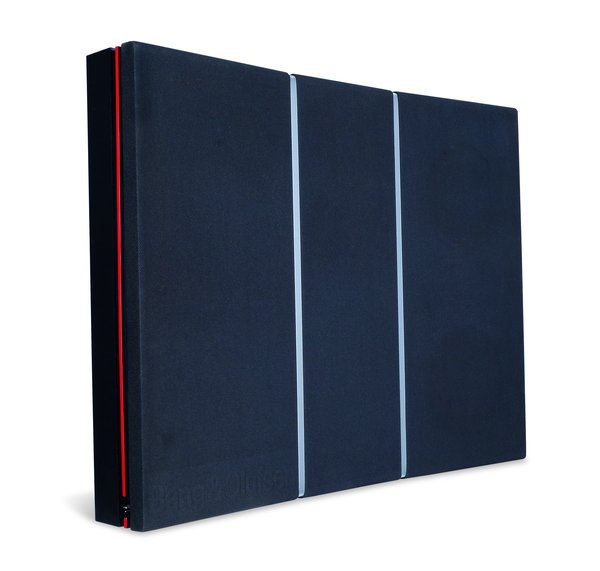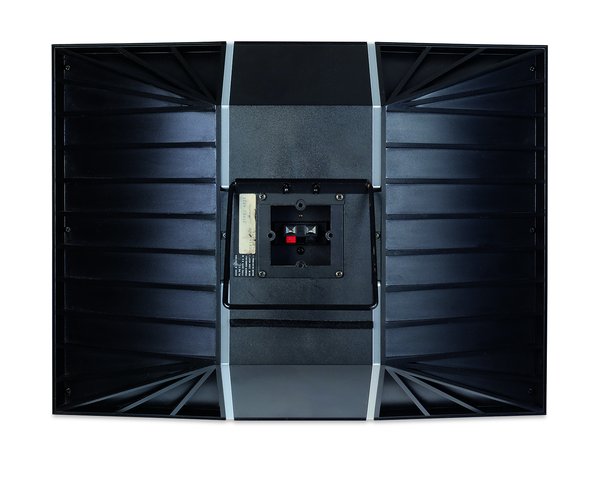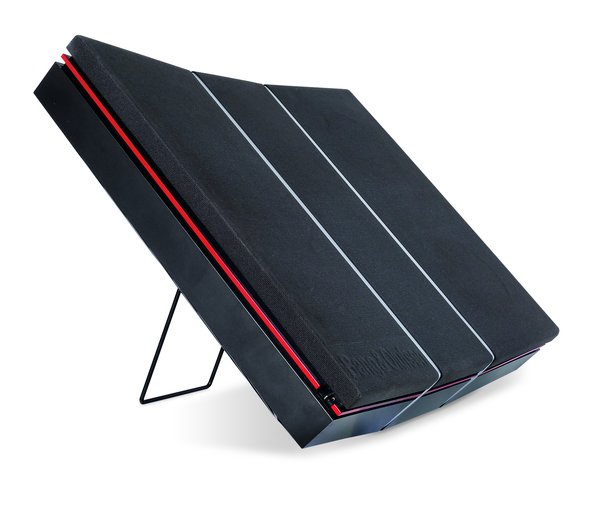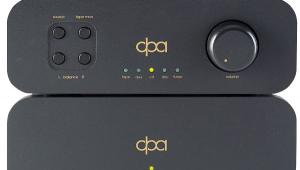Bang & Olufsen Beovox Red Line 60.2 Loudspeaker

 A very early use of laser interferometry saw B&O sculpt an injection-moulded speaker cabinet that controlled resonances and could be placed on the wall or floor...
A very early use of laser interferometry saw B&O sculpt an injection-moulded speaker cabinet that controlled resonances and could be placed on the wall or floor...
Imagine the difficulty of designing a high-quality loudspeaker with a radically new appearance. While buyers were happy to accept amplifiers, tuners and cassette decks with fascias that looked like the dashboard of a Concorde, speakers were furniture and so had to blend in - square box, plain grille and nothing more. If anyone could solve this problem it would be Bang & Olufsen, masters of creating designs that are at the same time futuristic-looking, appealing and enduring.
First In Line
In the early 1980s the firm had fully embraced the ultra slimline look with sophisticated computerised user interfaces and touch-sensitive logic controls. The matching loudspeakers though, with their cuboid cabinets veneered in rosewood or teak, were still stuck in the 1970s. Something had to be done to attract a new generation of listeners who wanted quality sound from something that looked a bit more up to date style-wise.
The Red Line range, first seen in 1985 and represented here by the Beovox RL 60.2, was B&O's answer. Gone was the wood, replaced instead by sculpted ABS (thermoplastic) mouldings. Gone too was the traditional presentation of the typical speaker, replaced by something that looked like a stage monitor from a futuristic and desperately elegant pop concert. Even the way the speakers were to be used had changed. Instead of a recommended 'correct' placement, which yielded the maker's desired results, the Red Line range was sold as a 'personal' speaker whose sound could be tailored to the owner's taste via placement options.
This is true for any loudspeaker, of course, but B&O was unusual for offering a choice of stands and brackets to make this is as easy as possible. As well as the basic horizontal floorstanding position there were stands to place the Red Lines vertically, like conventional loudspeakers. There were also wall and ceiling brackets for the more adventurous while owners were encouraged to move their Red Line speakers around to suit their mood. For completeness, coiled cables in matching red and black could be bought as an accessory.
The Red Line wasn't just the same old loudspeaker in a fancy box; it was technically innovative and full of novel refinements. The name 'Red Line' came from the colour of the laser beam that was employed for the holographic measurement of cabinet resonances, which formed part of the development programme - a first for B&O.
 The semi-transparent plastic strips are
not mere decoration but are clamped at the
rear, squeezing the front and rear halves of
the cabinet together. Note the DIN speaker
connection at the bottom edge of the cabinet
The semi-transparent plastic strips are
not mere decoration but are clamped at the
rear, squeezing the front and rear halves of
the cabinet together. Note the DIN speaker
connection at the bottom edge of the cabinet
Shape Shifting
The use of resin for the cabinets allowed the design to be highly optimised with internal ribbing and bitumen damping panels added to further attenuate unwanted resonances. B&O claimed a reduction in sound output from the cabinet rear of around 20dB when compared to a normal loudspeaker, something which was considered essential for wall mounting.
The unusual shape, with no parallel reflecting surfaces, further contributed to the low-colouration enclosure. The small cabinets (the internal volume of the RL 60.2 is just 19 litres) mandated some sort of porting to obtain the desired bass response, but a port scaled to the cabinet volume would have been small and 'breathy' sounding. This problem was solved in the first-generation RL 60 by using an ABR (auxiliary bass radiator), a large and heavy steel plate suspended freely on a foam rubber roll edge.
Two models were initially offered, both of similar size and appearance. The RL 45 was the basic package, priced at £165 and featured one 165mm woofer and 25mm soft dome tweeter, the latter sourced from Philips.
 The injection-moulded ABS
rear of the 60.2 includes a web of struts
that brace the structure, controlling
cabinet resonances. Spring-clip cable
terminals are set into a small, central box
surrounded by the speaker’s hinged wire
‘foot’
The injection-moulded ABS
rear of the 60.2 includes a web of struts
that brace the structure, controlling
cabinet resonances. Spring-clip cable
terminals are set into a small, central box
surrounded by the speaker’s hinged wire
‘foot’
On A Roll
The second model was the RL 60. This cost £225 and was slightly deeper. It used the same tweeter, but the bass was handled by two specially designed 130mm woofers from Standard Electrik Lorenz, the German subsidiary of the multinational giant ITT. It was designed for good transient response and used an unusually powerful magnet to improve sensitivity.
The use of two woofers brought an unexpected problem connected with the idea of flexible placement. Since the loudspeaker could potentially face the listener at a variety of different angles the time domain relationship between the two units was not constant. To help mitigate any possible cancellation effects at higher (bass/mid) frequencies one of the units was rolled-off at above 200Hz, the other working into the midrange.
Clever though they were, the first Beovox Red Lines did not meet with universal acclaim. B&O loyalists bemoaned the loss of those silky veneers while others stuck with the old mantra of 'what looks good can't sound good'. They may have had a point on this occasion. The RL 45 sounded dry and unexciting in many situations and the RL 60, although an improvement, was no rival for B&O's older Uniphase models in terms of sound. A rethink was required.
The RL 45.2 and RL 60.2 that followed in 1987 dispensed with the troublesome ABR, replacing it with (of all things) a small high-velocity port. At the same time, the Philips tweeter was swapped for a Danish-made Vifa unit and the crossover circuits were lightly revised. Clearly the original port assumptions were unfounded as these changes transformed the loudspeaker, making the cheaper model far more acceptable and the more expensive one quite special.
By this stage comprising four models, the RL range remained in production in this form until B&O stopped making large passive loudspeakers. The newcomers were the RL 35 miniature and RL 140 full-sized model. These later became the RL 1000 (previously the RL 35), the RL 2000 (RL 45.2), RL 6000 (RL 60.2) and RL 7000 (RL 140) after a mild re-style in the early '90s. There were no technical changes of note.
 Seen here leaning back on its floor
support, the Red Line 60.2’s two-piece
enclosure combines a reinforced ABS chassis
(curved to eliminate standing waves) with a
foamed polystyrene baffle
Seen here leaning back on its floor
support, the Red Line 60.2’s two-piece
enclosure combines a reinforced ABS chassis
(curved to eliminate standing waves) with a
foamed polystyrene baffle
Tim Listens
Nearly 40 years later, the design has lost none of its impact. Small, squat, angled floorstanders are unusual, and while set up in my listening room they attracted a lot of attention. Up on the stands they look more familiar, but our guests were still surprised that they contained traditional drive units and not an exotic technology like electrostatic panels (or warp drive…). Connection to a normal amplifier is simple as there are standard spring clips located in a recess in the back, which will take bare-ended cables. There is also a male DIN plug in one corner for the B&O red and black curly cables, provided you can find a set as they are not especially common.
Punching Up
As the model number suggests, their 'power rating' is a nominal 60W, which means that most small-to-middleweight amplifiers are suitable. Putting the RL 60.2s on the floor affords an additional bass lift, which is not dissimilar to siting any other loudspeaker close to the wall, but as the stands can now be difficult to find I chose to audition them in this position.
Floor positioning results in a big and punchy sound. The first surprise was how good these speakers are when one is standing up or moving around the room, something normal designs don't do. Ideal for parties then, as is the RL 60.2's ability to soak up lots of power and play very loudly for long periods without showing any signs of distress. Despite the two bass units crossing over at different points these Red Line units still sound like a two-way (two-and-a-half way) loudspeaker with two small bass units rather than a genuine three-way design, the tell-tale trait being a midband presence dip [again, see PM's Lab Report, p125] that can suck vocals back in the mix.
The rest of the sound is typical B&O: rich, creamy smooth and indulgent. To have taken the essential character of the firm's big wooden boxes and squeezed it into these radical looking little sculptures was a remarkable achievement, although there are some drawbacks.
The RL 60.2's limitation, when used on the floor at least, is a slightly overblown bass which can smudge low frequency detail. This is a common trait with many types of loudspeaker that use boundary gain to boost their low-end response, and in B&O's defence it does at least avoid a heavy 'one note' character. The treble, too, is slightly soft in the usual B&O manner, so if you like loudspeakers to possess real bite these may not be an ideal choice.
Up To Scale
On the other hand, stereo imaging is excellent, which was a real surprise given the speaker's unusual positioning. The RL 60.2s project a broad image that was subjectively about a metre off the ground, quite outside their cabinet boundaries. I had worried it would be difficult to be convinced by an orchestra that was only a foot tall, but this problem has been addressed.
Another potential issue is the dispersion/response uniformity of the Vifa soft dome tweeter when the RL 60.2 is heard significantly off-axis, as when the speaker is placed on the floor or hung from the ceiling. Mozart's Horn Concerto In E flat [Philips 422 330-2] demonstrated the ability of these units to generate an easily accessible sense of orchestral scale.
The loudspeakers created a soundstage of impressive width and solidity with very little concentration being required to locate each group of players. Being critical one could say the sound has a 'smoothed over' quality to it, but not necessarily in an obtrusive way or in a manner that spoils the enjoyment of the music.
I was also keen to explore B&O's claims for the 'fast' response of the woofers used in the RL 60.2. To this end 'Physical Presence' by Level 42 [World Machine; Polydor 872 487-2] was played with speed and gusto - with material like this I can see what B&O meant! The heavy percussion does indeed have a real feeling of attack, although some overhang from the floor placement is an inevitable by-product.
What is really impressive is how the sound from what, in practice, is a fairly small pair of loudspeakers holds together at extended volume settings. The sturdy cabinets are clearly coming into play here, or not as the case may be… Again the treble was perhaps a little muted when listening at the edges of the tweeter's field, but its extension improved considerably by moving closer (or standing up…).
The RL range has always been controversial but I think it's fair to say that the design fulfilled its initial promise in this second iteration. It is the sweet spot in the range; the miniature RL 35 lacks many of the key RL technologies while the big RL 140 is difficult to find and suffers with problems with its foam roll edges. I really enjoyed my time with these loudspeakers - they are neat, stylish and, best of all, sound great.
Buying Secondhand
RL 60.2s are easy enough to find and are typically inexpensive but many now have grille cloths worn through at the corners and holed or snagged in the middle. These are heat-formed over the baffles and cannot be replaced easily, so hold out for a tidy pair. The two plastic bands that wrap around the cabinet disintegrate with age too, but after-market replacements are available.
The drive units and crossover components seldom (if ever) fail, just as the woofer's roll edges are made from rubber that does not deteriorate. But bear in mind that the stands may cost you more than the speakers if bought separately.























































